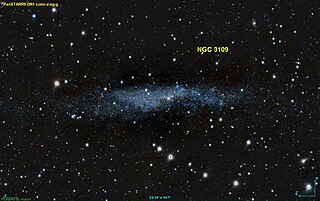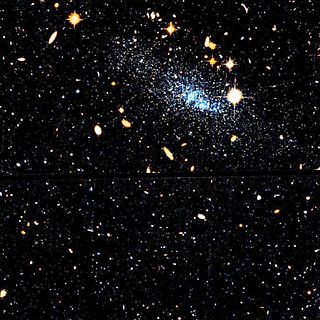Related Research Articles

A globular cluster is a spheroidal conglomeration of stars that is bound together by gravity, with a higher concentration of stars towards their centers. They can contain anywhere from tens of thousands to many millions of member stars, all orbiting in a stable, compact formation. Globular clusters are similar in form to dwarf spheroidal galaxies, and the distinction between the two is not always clear. Their name is derived from Latin globulus. Globular clusters are occasionally known simply as "globulars".

The Local Group is the galaxy group that includes the Milky Way, where Earth is located. It has a total diameter of roughly 3 megaparsecs (10 million light-years; 9×1019 kilometres), and a total mass of the order of 2×1012 solar masses (4×1042 kg). It consists of two collections of galaxies in a "dumbbell" shape; the Milky Way and its satellites form one lobe, and the Andromeda Galaxy and its satellites constitute the other. The two collections are separated by about 800 kiloparsecs (3×106 ly; 2×1019 km) and are moving toward one another with a velocity of 123 km/s. The group itself is a part of the larger Virgo Supercluster, which may be a part of the Laniakea Supercluster. The exact number of galaxies in the Local Group is unknown as some are occluded by the Milky Way; however, at least 80 members are known, most of which are dwarf galaxies.

In 1944, Walter Baade categorized groups of stars within the Milky Way into stellar populations. In the abstract of the article by Baade, he recognizes that Jan Oort originally conceived this type of classification in 1926.

A dwarf galaxy is a small galaxy composed of about 1000 up to several billion stars, as compared to the Milky Way's 200–400 billion stars. The Large Magellanic Cloud, which closely orbits the Milky Way and contains over 30 billion stars, is sometimes classified as a dwarf galaxy; others consider it a full-fledged galaxy. Dwarf galaxies' formation and activity are thought to be heavily influenced by interactions with larger galaxies. Astronomers identify numerous types of dwarf galaxies, based on their shape and composition.

A dwarf spheroidal galaxy (dSph) is a term in astronomy applied to small, low-luminosity galaxies with very little dust and an older stellar population. They are found in the Local Group as companions to the Milky Way and as systems that are companions to the Andromeda Galaxy (M31). While similar to dwarf elliptical galaxies in appearance and properties such as little to no gas or dust or recent star formation, they are approximately spheroidal in shape and generally have lower luminosity.

The Sculptor Dwarf Galaxy is a dwarf spheroidal galaxy that is a satellite of the Milky Way. The galaxy lies within the constellation Sculptor. It was discovered in 1937 by American astronomer Harlow Shapley using the 24-inch Bruce refractor at Boyden Observatory. The galaxy is located about 290,000 light-years away from the Solar System. The Sculptor Dwarf contains only 4 percent of the carbon and other heavy elements in our own galaxy, the Milky Way, making it similar to primitive galaxies seen at the edge of the universe.

IC 1613 is an irregular dwarf galaxy, visible in the constellation Cetus near the star 26 Ceti. It was discovered in 1906 by Max Wolf, and is approaching Earth at 234 km/s.

The Pisces Dwarf, also known as Pisces I, is an irregular dwarf galaxy that is part of the Local Group. The galaxy, taking its name from the constellation Pisces where it appears, is suspected of being a satellite galaxy of the Triangulum Galaxy (M33). It displays a blueshift, as it is approaching the Milky Way at 287 km/s. It may be transition-type galaxy, somewhere between dwarf spheroidal and dwarf irregular. Alternatively, it may be a rare, but statistically acceptable, version of one of the two types.

The Boötes Dwarf Galaxy is a galaxy discovered in 2006, which appears faint, with a luminosity of 100,000 L☉ and an absolute magnitude of –5.8. It lies about 197,000 light-years away in the constellation Boötes. This dwarf spheroidal galaxy appears to be tidally disrupted by the Milky Way Galaxy, which it orbits, and has two stellar tails that cross over to form a cross. Tidally disrupted galaxies usually only form one tail. The galaxy appears to be significantly elongated, with an ellipticity of ε = 0.68 ± 0.15.
A blue blob is a type of stellar system found in intergalactic space. Blue blobs usually consist of several clusters and star-forming regions within a few kpc, with no sign of an older stellar population. There is nothing in the vicinity of these blue blobs, as they are surrounded by intergalactic space, sometimes for hundreds of kiloparsecs. Currently, 5 blue blobs are known, all located in the Virgo Cluster. Blue blobs are also sometimes known as Ram Pressure Dwarfs, due to their formation likely being due to ram-pressure stripping of gas from nearby galaxies, which drifted through intergalactic space and then went through starburst, producing these blue blobs.

A Pea galaxy, also referred to as a Pea or Green Pea, might be a type of luminous blue compact galaxy that is undergoing very high rates of star formation. Pea galaxies are so-named because of their small size and greenish appearance in the images taken by the Sloan Digital Sky Survey (SDSS).
The Pisces Overdensity is a clump of stars in the Milky Way's halo, which may be a disrupted dwarf spheroidal galaxy. It is situated in the Pisces constellation and was discovered in 2009 by analysis of distribution of RR Lyrae stars in the data obtained by the Sloan Digital Sky Survey's data. The galaxy is located at the distance of about 80 kpc from the Sun and moves towards it with a speed of about 75 km/s.

NGC 5053 is the New General Catalogue designation for a globular cluster in the northern constellation of Coma Berenices. It was discovered by German-British astronomer William Herschel on March 14, 1784 and cataloged as VI-7. In his abbreviated notation, he described it as, "an extremely faint cluster of extremely small stars with resolvable nebula 8 or 10′ diameter, verified by a power of 240, beyond doubt". Danish-Irish astronomer John Louis Emil Dreyer reported in 1888 that the cluster appeared, "very faint, pretty large, irregular round shape, growing very gradually brighter at the middle".

The Antlia-Sextans Group is a small Galaxy group in the constellations Hydra, Sextans, Antlia and Leo. It is, on average, approximately 4.3 million light-years away from the Milky Way. It is generally considered to be at the very edge of the Local Group and thus part of it. However, other researchers indicate it is an independent Galaxy group, unlikely to be gravitationally bound to the Local Group due to probably lying outside the Local Group's Zero-velocity surface, and thus the nearest Galaxy group to the Local Group rather than a subgroup within the Local Group. Nonetheless—this possible independence may disappear as the Milky Way continues coalescing with Andromeda due to the increased mass, and density thereof, plausibly widening the radius of the Zero-velocity surface of the Local Group.

Leo P is a small, star-forming irregular galaxy located in the constellation Leo, discovered through the blind HI Arecibo Legacy Fast ALFA (ALFALFA) survey, as an ultra-compact high-velocity cloud (UCHVC) of hydrogen gas. Its confirmation as a dwarf galaxy in 2013 suggests that other such UCHVCs are possibly undiscovered dwarf galaxies themselves. Leo P is noteworthy for harbouring one of the most metal-poor environments in the local universe. Its metallicity is just 3% that of the Sun's, meaning that its stars contain 30 times less heavy elements than the Sun. This makes Leo P similar to the pristine environments of primordial galaxies.

PHL 293B, also known as Kinman's dwarf, is a low-metallicity blue compact dwarf galaxy about 22.6 Mpc from the Earth in the constellation Aquarius.
Evan David Skillman is an American astronomer and astrophysicist.

The Peekaboo Galaxy is an irregular compact blue dwarf galaxy in the constellation Hydra. The galaxy is relatively small, at about 1,200 light-years (0.00037 Mpc) across. It is also relatively nearby, at a distance of around 22 million light-years (6.7 Mpc) from Earth. The Peekaboo Galaxy is considered one of the most metal-poor, least chemically enriched, and seemingly primordial, galaxies known.
References
- 1 2 Aver, Erik; Berg, Danielle A.; Hirschauer, Alec S.; Olive, Keith A.; Pogge, Richard W.; Rogers, Noah S J.; Salzer, John J.; Skillman, Evan D. (2021). "A comprehensive chemical abundance analysis of the extremely metal poor Leoncino Dwarf galaxy (AGC 198691)". Monthly Notices of the Royal Astronomical Society. 510: 373–382. arXiv: 2109.00178 . doi: 10.1093/mnras/stab3226 .
- ↑ Aron, Jacob (21 May 2016). "The galaxy that time forgot". New Scientist. 230 (3074): 12.
- ↑ Nowakowski, Tomasz (16 March 2016). "Astronomers discover the most metal-poor galaxy in the local universe". phys.org. Retrieved 8 June 2016.
- ↑ Hirschauer, Alec S.; Salzer, John Joseph; Cannon, John M.; Skillman, Evan D. (1 January 2016). "The Extremely Metal-Poor Dwarf Galaxy AGC 198691". American Astronomical Society. 227: 136.06. Bibcode:2016AAS...22713606H.